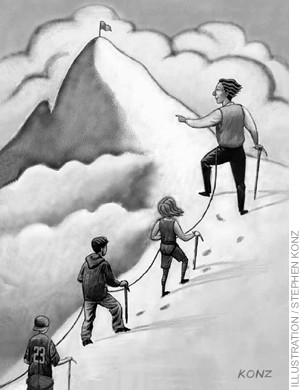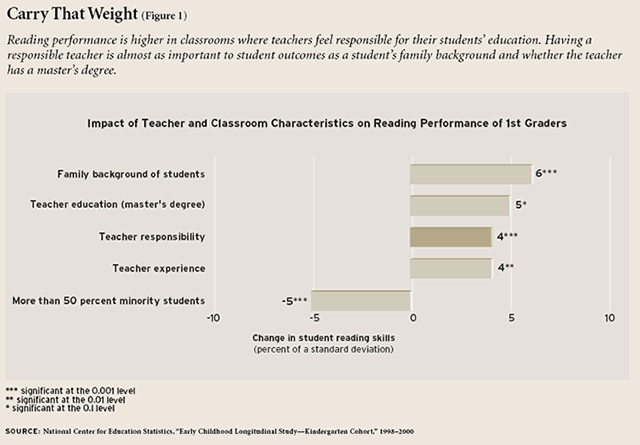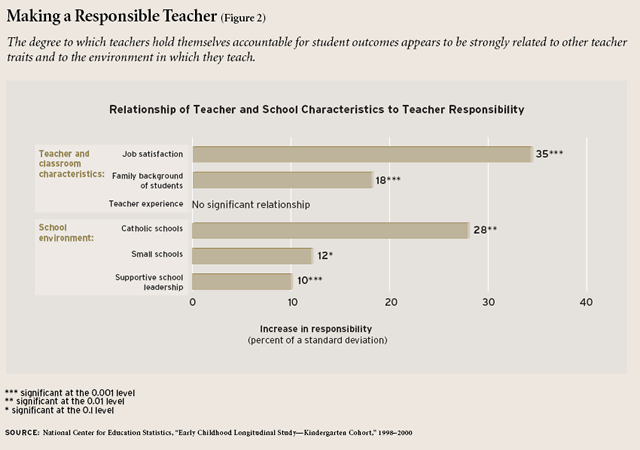
The basics of No Child Left Behind (NCLB)—adequate yearly progress benchmarks, provision of supplemental services, and a “highly qualified” teacher in every classroom—are known. And the intense scrutiny of the “how to” of those basics has resulted in a mix of impassioned criticism and effusive praise. But what has been left largely unexamined in the hubbub is perhaps the law’s central, if unspoken, principle: that a serious commitment to learning-for-all can help make it so.
Indeed, the NCLB legislation calls for “greater responsibility” from teachers and schools for student learning. Yet we know very little about whether a teacher’s own sense of responsibility for that learning makes any difference to student achievement. We know even less about how to nurture that sense of responsibility. I set out to explore both questions.
My study of a nationally representative sample of 1st graders and their teachers suggests that teachers who take personal responsibility for student learning can improve student achievement; specifically, children with teachers who have a greater sense of responsibility for student outcomes learn more in reading during the 1st grade. Unfortunately, the findings presented here also suggest that the teachers of economically disadvantaged students, the very students NCLB targets as most in need of teachers and schools that take responsibility for their learning, are less likely to take responsibility for student outcomes.
The way forward, however, should not be dedicated solely to the daunting task of identifying, hiring, and retaining more responsible teachers. I found that a teacher’s work environment has a strong relationship with her commitment to student learning. Teachers who report that their school’s leadership is supportive of their efforts in the classroom have a much greater senseof responsibility, as do teachers in Catholic schools. Improving the quality of school leadership could also be an effective means of staffing our nation’s classrooms with responsible teachers.
Teacher Responsibility and Student Learning
To find out whether a teacher’s sense of responsibility affects student learning, I first had to define the terms. I determined that a teacher has a sense of responsibility when she willingly accepts credit for students’ positive outcomes and also accepts blame for their negative outcomes. Rather than attribute poor grades or low test scores to faults within students or to deficits in their backgrounds, responsible teachers attribute much of the cause to their own efforts and behavior. At its best, responsibility represents a teacher’s commitment to make learning happen for her students.
And though student achievement is easily defined, I did have to account for a host of other potential influences on it, including other teacher characteristics (such as certification status, post-college coursework, and years of experience as a 1st-grade teacher), the student’s social background (family income), classroom characteristics (average family income, percent minority), and, most important, the student’s previous achievement (kindergarten test score). Accounting for such social and academic background characteristics does temper the concern that teachers with strong senses of responsibility are more likely to select high-achieving students.
To capture the strength of a teacher’s sense of responsibility for student learning, I took advantage of the Early Childhood Longitudinal Study–Kindergarten Cohort (ECLS–K) prepared by the National Center for Education Statistics (NCES). The ECLS–K is the only national data set that links information on teachers’ attitudes to student outcomes. It is based on periodic surveys that track information on a nationally representative sample of elementary-school students, their teachers, and the 1,280 public and private schools they attend. I focused my research on 1st-grade teachers of students who had been surveyed as kindergartners in 1998, the study’s first year. The study sampled students, not teachers, so my findings may be generalized to teachers of a nationally representative sample of 1st-grade students, but not a nationally representative sample of 1st-grade teachers. But the sample of teachers does look fairly representative. Nearly 20 percent of the 1st-grade teachers are of minority ethnicity, and more than one-third have earned a master’s degree.
A teacher’s answers to four survey items were summed to create an index of the strength of a teacher’s sense of responsibility for student learning. Teachers were asked to respond to certain statements by locating their attitudes on a 5-point scale, with 1 being strongly disagree and 5, strongly agree. In building the index, I reversed the values of the responses to the last three items: the more a teacher agreed with the statements that students were not capable of something, the lower she would score on the teacher responsibility index. Itracked teacher agreement with four statements:
- I make a difference in the lives of the children I teach.
- Many of the children I teach are not capable of learning the material I am supposed to teach them.
- The level of child misbehavior (noise, horseplay, or fighting) in this school interferes with my teaching.
- Routine duties and paperwork interfere with my teaching.
The latter two items focus on problems or costs in the school environment that teachers may believe prevent them from instructing children effectively. Unruly children or excessive paperwork, for example, can become a reason teachers do not feel responsible for achieving instructional goals; the problem, they may say, lies with the students or with the school. Routine duties and paperwork can also shift teachers’ perceptions of themselves as professionals in charge of, and responsible for, children’s learning to a perception of themselves as hassled paper-pushers. Teachers can thus attribute their failure to reach instructional goals to a lack of time and energy caused by being overwhelmed by chores that bear little relevance to their classroom. They become responsible for paperwork, not pedagogy.
Although they are not as highly correlated as most index items designed in advance for a particular purpose, the four items I use to construct the responsibility scale are all positively correlated with one another at statistically significant levels (0.09–0.28). Just a tenth of the 1st-grade teachers consider their very young students incapable of learning. Teachers’ responses to this question do not vary widely, and the modal response is “disagree.” However, these are very young children who have a relatively short history of achievement. The fact that 10 percent of teachers think that by age six these students cannot learn is significant. More than a fifth of the teachers in the sample consider children’s misbehavior somewhat of a concern in their attempts to teach. About 17 percent agree or strongly agree that misbehavior in the school affects their teaching. An overwhelming majority of teachers (95 percent) agree that they make a difference in children’s lives. Not surprisingly, the most variation exists in teachers’ answers to the paperwork question, with the modal response “agree” and the median response “neither agree nor disagree.” Agreement and disagreement are approximately equal on whether paperwork is a problem.
First-grade reading achievement was measured with scores on a standardized reading test given to students near the end of the 1st grade as part of the Early Childhood Longitudinal Study (ECLS). I focus on the reading test because literacy skills are more heavily emphasized than arithmetic in school curricula for the early grades.
In an effort to measure more precisely each child’s performance, the test was tailored to each student. A first stage provided a rough estimate of a student’s achievement level, and students’ performance here determined the difficulty of the items in the second stage of the assessment. By giving students questions that were appropriate to their level of cognitive development, researchers could more accurately pinpoint a student’s achievement level. The most basic test items required students to identify upper- and lower case letters of the alphabet. The most advanced items asked students to determine the meaning of potentially unfamiliar words from context. The raw scores on the assessments were standardized to allow for comparison across grade levels.
Throughout my analysis of the test-score data, I accounted for differences in previous student achievement, according to ECLS results, by adjusting for each student’s achievement at the end of kindergarten. I also adjusted the 1st-grade achievement measure to account for differences in instructional time spent in kindergarten and first grade.
Responsibility Matters
My results show that a teacher’s sense of responsibility for student learning does seem to make a positive difference in a student’s reading achievement at the end of 1st grade. An increase of one standard deviation in the strength of a teacher’s sense of responsibility is correlated with an increase in a student’s 1st-grade reading skills of .04 of a standard deviation (see Figure 1).

This seemingly small amount is important. The data show that about 10 percent of the difference between teachers in 1st-grade reading achievement can be explained by characteristics of the teacher. Teacher responsibility alone can explain as much as 4 percent of this variation between teachers. I found this to be as large a relationship as two traditional indicators of teacher’s quality: whether the teacher holds a master’s degree and years of experience as a 1st-grade teacher. This result is particularly important in light of the fact that much of a teacher’s contribution to student achievement remains unexplained.
Because this study was a snapshot in time of 1st-grade teachers and their students during one school year, I cannot claim with complete certainty that a teacher’s sense of responsibility causes increases in student achievement. It is a chicken-and-egg problem: did the teacher’s sense of responsibility improve student achievement, or do high-achieving students make a teacher more likely to take responsibility for her students? At least with respect to student achievement, however, the data do provide hints as to what is cause and what is effect. While a teacher’s sense of responsibility is not related to the average previous academic achievement level of a class, it is associated with the achievement gains individual students make while they are in her classroom. This strongly suggests that teacher responsibility affects achievement, not vice versa.
Identifying Committed Teachers
Since teachers who hold themselves accountable help students learn more, we should want to know who these teachers are and where they work. I measured the relationship between an individual teacher’s sense of responsibility and his or her personal and professional background, attitudes toward work (including job satisfaction), students’ social class (average family income), and the characteristics of the school in which she taught. I found that 70 percent of the variation in teacher responsibility can be traced to the background characteristics of the teachers and of their students, while the remaining 30 percent is attributable to school environment. A teacher’s gender or ethnicity makes no difference in her level of responsibility. When we look at professional background, teachers who have completed more coursework in education express a slightly weaker sense of responsibility than those with less coursework. Other professional background characteristics, however, are unrelated to teacher responsibility. Teacher certification and experience, two of the cornerstones of NCLB’s “highly qualified” teacher requirements, are not associated with having this commitment.
In contrast to the background characteristics, teachers’ attitudes are related to responsibility. As a teacher’s satisfaction with her work increases, her sense of responsibility for student outcomes rises substantially. An increase in job satisfaction of one standard deviation leads to a 0.35 standard deviations increase in responsibility. (See Figure 2.) But teachers who believe that children should know basic reading skills before reaching 1st grade are less likely to hold themselves accountable for student learning. An increase of one standard deviation in expectations about student preparation is associated with a 0.05 standard deviation reduction in responsibility.

Perhaps surprisingly, the same negative relationship exists between a teacher’s endorsement of daily homework for 1st graders and responsibility. First-grade teachers who expect students to
arrive at school with basic reading skills and who endorse daily homework may wish to downplay their responsibility and highlight parents’ and children’s responsibility for school success. Teachers with greater confidence in their instruction of learning-disabled students or students with limited English proficiency have a greater sense of responsibility (each associated with an increase of 0.06 standard deviations).
My findings also suggest that teacher responsibility is related to the characteristics of the students in the teacher’s classroom. Student characteristics may influence teachers’ expectations for student success and teachers’ attitudes toward responsibility for their learning. Previous research has shown that teachers tend to perceive students from lower-income families as inadequately prepared for school and to set lower achievement expectations for them than for students from higher-income families. In line with these earlier studies, I find that the less financially well-off a teacher’s students are, the less responsibility she takes for their learning (a decrease of 0.18 standard deviations in responsibility for each standard deviation decrease in family income).
School Environment and Teacher Responsibility
The characteristics of a teacher’s students matter, but they are less important than where a teacher works. After we adjust for the teacher and student influences, school environment explains almost one-third of the differences in teacher responsibility. Teachers who work in small schools (fewer than 300 students) and in schools with less than 50 percent minority enrollment had a greater sense of responsibility for student learning.
Regardless of the other characteristics of a school, supportive administrative leadership can make a substantial difference in whether teachers hold themselves accountable for student learning. If a school’s teachers think that school leaders set and support clear goals for teachers and have the ability to protect and encourage staff, individual teacher’s responsibility scores tend to be higher. It is interesting that teachers’ sense of professional community, faculty collaboration, and teacher empowerment, which could all reasonably be thought of as influenced by the school administration, were unrelated to teacher responsibility.
The Catholic School Advantage
Teachers in Catholic schools scored 0.28 standard deviations higher on the responsibility index than their public-school counterparts did. This could be explained by the commitment held by many Catholic schools to creating a strong community and to helping all students learn.
It is possible that the most responsible teachers may choose to work in Catholic schools, which can be selective in their student admissions, in order to teach children with more academic and social advantages. In fact, the Catholic-school students in this study have higher average academic abilities and higher average family incomes than students in public schools. Yet the Catholic-school benefit to teacher responsibility persists even after accounting for the measured characteristics of a school’s student body.
Of course, it may be that teachers who choose to work in Catholic schools are already committed to the respect, care, and other values that they know many Catholic schools espouse. The Catholic-school finding might also be disguising unmeasured characteristics of students—such as good behavior—that make teachers more likely to accept responsibility for the students’ outcomes. These possibilities make it difficult to sort out whether it is the Catholic school, the reason the teacher accepted employment at the school, the unmeasured student characteristics, or some combination of these that strengthens a teacher’s sense of responsibility for student learning.
A Prescription for Accountable Teachers
What can be done to staff classrooms with teachers who take more responsibility for student learning? Although NCLB requires that schools have “highly qualified” teachers, a category defined by certification and experience, my analysis indicates that responsibility is not linked to these characteristics. It is easy to see why the law’s authors chose the approach they did: academic qualifications are far more easily identifiable by principals making hiring decisions than intangible attributes such as a sense of responsibility.
Yet some organizations have sought out teachers with such characteristics as teachers’ enthusiasm for work and sense of responsibility for student learning. Teach for America (TFA) administrators, for instance, consider these to be among the most important attributes in good teacher candidates. And the TFA application process has been shaped to tease them out, including a daylong interview session with 12 candidates, during which trained interviewers look for evidence of a prospective teacher’s responsibility quotient.
Public schools should incorporate some of these same recruitment and selection techniques. Currently, some school districts sift through résumés to hire personnel, or rely upon quick meetings with candidates at large job fairs. It is doubtful that district officials in charge of hiring decisions can tell if teachers possess the personal attributes to lead a classroom after such brief meetings. Even if the one-on-one, extended interview that TFA conducts is too time-consuming and costly for a school district, people with hiring power could meet with teacher candidates one-on-one and ask pertinent, piercing questions about the candidates’ approaches to solving problems that commonly arise in teaching. And analyzing a candidate’s answers to questions like the ones posed by ECLS–K investigators during their study, in addition to the routine résumé review, could give districts a much better idea which prospective teachers are willing to hold themselves accountable for a student’s progress.
In the meantime, we should look to the quality of school leadership to bolster a sense of commitment among teachers. Supportive school leadership seems to create the environment in which teachers willingly accept responsibility for students’ progress and in which students learn.
-Laura LoGerfo is a research associate at the Urban Institute’s Education Policy Center in Washington, D.C.


